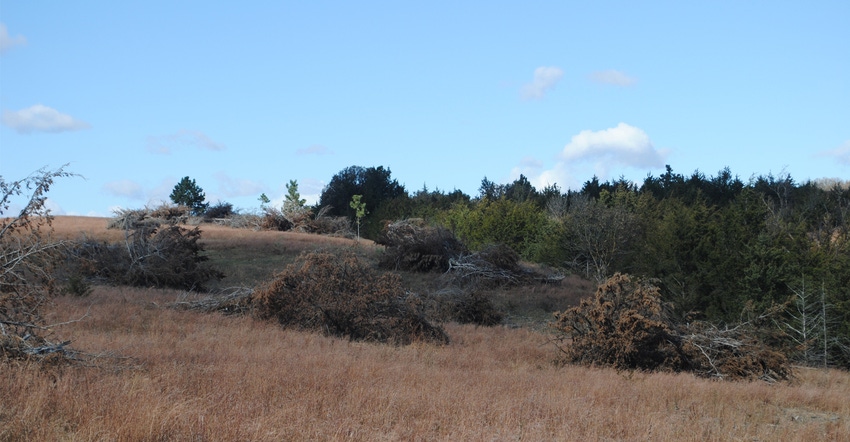
Mechanical clearing is one of the most-employed means of clearing out invasive eastern red cedar trees from grazing lands across the Plains and Mountain West.
Along with prescribed fire, mechanical methods work well, but how should mechanical clearing be applied to the land, and what should landowners do with slash piles left behind? There are several strategies that can be used when clearing land from cedars.
“The Nebraska Forest Service encourages developing fire lanes, clearing out entire areas and other management techniques,” says Beth Arens, University of Nebraska eastern area forester with NFS. “It depends on the property, goals of the fuels program and the landowner.”
As far as mechanical clearing, Arens recommends either mulching or piling the slash left behind.
“Mulching looks the cleanest, but you have to be careful not to let the mulch get too thick,” she says. “We recommend spreading the slash out, so the majority of it is not more than 6 inches deep to allow the vegetation to grow through the mulch.”
If the mulch is too thick, or if it is just piled up, it kills the vegetation underneath.
Handling slash piles
“If the slash is piled, make sure that it is no closer than 30 feet from the dripline of existing trees. Keep the piles smaller and manageable, and burn the piles after a year, once you have obtained a burn permit” from local authorities, Arens explains. “Or you can hire a contractor to take care of the piles for you. Piling may be cheaper up front to get rid of your cedar trees, but if you are paying someone to additionally burn your piles, it may be more expensive” in the long run.
Slash piles can be burned during a prescribed fire, which is often done, but they can also be burned at a separate time. Some landowners leave some slash piles for use by wildlife.
“We typically like to see most of them cleaned up to get rid of the hazardous fuels,” Arens notes. “If you cut and pile and then never remove the pile, you are just rearranging the fuels, not reducing the fuels.” The more fuel there is, the more intense a wildfire can be.
Arens says that slash piles to be burned with prescribed fire on the same property can be pushed up close to target trees. If the piles are to be burned later and independently from a prescribed burn, they need to be away from the dripline of trees and out in the open. “Either way, you have to get a burn permit, and you need to follow safety guidelines,” Arens adds.
In many cases, state agencies have funding available to help reduce the cost of fuels to the landowner. Landowners should check with their local and state forest service and forester for more information about programs and funding available.
About the Author(s)
You May Also Like






